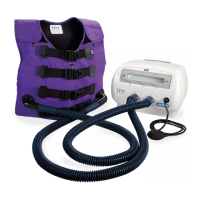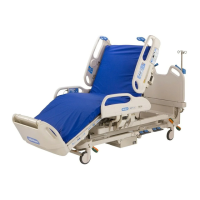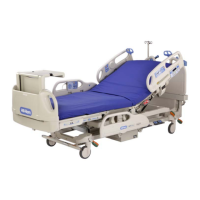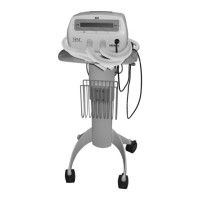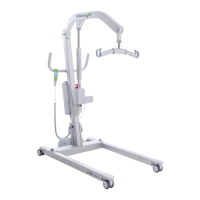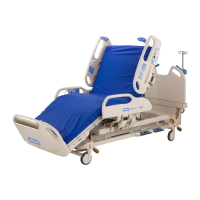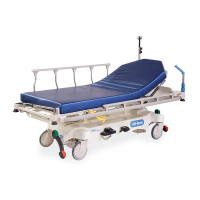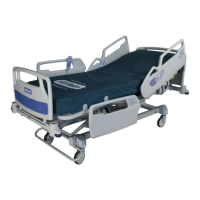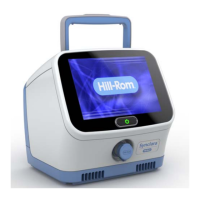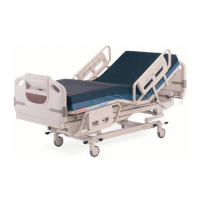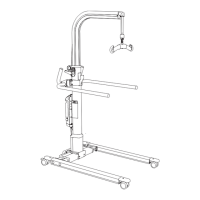Do you have a question about the Hill-Rom Volara PVL1 and is the answer not in the manual?
Manual providing instructions for Volara System.
Identifies the product number of the Volara System.
Legal restriction on device sale and distribution in the USA.
Details copyright, patents, manufacturer, and legal restrictions.
Reference to a related service manual.
Describes the intended purpose and target patient demographic for the Volara System.
Overview of the manual's content and essential safety information.
Explains how the Volara System works and its therapy modes (CHFO, CPEP).
Specifies indications for the Volara System.
Lists absolute and relative contraindications for the system.
Lists potential adverse effects patients may experience during therapy.
Explains typefaces, symbols used in the manual and on the system.
Lists symbols shown on the touchscreen and defines system acronyms.
General safety precautions for using electrical products.
Warnings regarding operation, environment, and handling.
Warnings related to battery safety and MR Unsafe status.
Cautions to prevent equipment damage, including battery handling.
Identifies components on the front and back of the control unit.
Identifies components of the single-use patient circuit.
Warnings for assembly and connection safety, including bio-filter use.
Steps to connect the Volara patient circuit to the system.
Instructions for connecting the circuit for in-line ventilation.
Instructions for connecting the system to an oxygen source.
Steps for assembling and filling the nebulizer kit with medication.
Steps for setting up and powering on the control unit.
Steps for powering off and storing the system components.
Describes the home and options menus for Volara Therapy.
Instructions for starting therapy in automatic and manual modes.
Describes the basic view of the automatic mode screen and its controls.
Instructions for adjusting cough pause settings in preset therapy plans.
Instructions to access advanced view and describes manual mode basics.
Instructions for starting therapy in manual mode and using controls.
Instructions for creating a new preset therapy plan.
Instructions for modifying an existing preset therapy plan.
Instructions for renaming a preset therapy plan.
Instructions for deleting a preset therapy plan.
Instructions for using Volara System with an in-line ventilator.
Instructions for adjusting screen brightness.
Instructions for adjusting date and time settings.
Instructions for changing the system language.
Instructions for enabling or disabling Clinical Access.
Instructions for setting the pressure ceiling limit.
Instructions for connecting Bluetooth devices like barcode readers or pulse oximeters.
Instructions for connecting to local, public, and enterprise WiFi networks.
Instructions for testing connections to VisiView portal and EMR.
Instructions for retrieving and exporting therapy and error logs.
Instructions for importing and exporting device settings.
Instructions for viewing firmware version and system information.
Lists available accessories with part numbers.
Detailed information, warnings, and cautions for the replaceable battery.
Instructions for installing the replaceable battery.
Explains battery status symbols and LED indicators.
Instructions for charging the battery.
Detailed information about the pulse oximeter and its connection.
Instructions for assembling the mobile stand and pole clamp.
Instructions for mounting the control unit on the cart assembly.
Instructions for safely moving the mobile stand.
Instructions for mounting the control unit on a medical rail or IV pole.
Lists available replacement parts and their part numbers.
General warnings, cautions, and procedures for cleaning and disinfecting.
Instructions for cleaning the unit and stand with cart.
Instructions for cleaning the pulse oximeter.
Instructions for cleaning the single-use patient circuit.
Examples of bio-filter damage and disinfection recommendations.
Instructions for maintaining the inlet and nebulizer filters.
Instructions for replacing the system fuse.
Details the expected service life for the control unit, circuit, and battery.
Information on contacting for service and necessary details.
Steps for troubleshooting control unit power problems.
Instructions on how to access the system's on-screen help feature.
Explains audible beep patterns and their meanings.
Explains on-screen notification messages and their purpose.
Explains warning messages and provides solutions for error codes.
Explains caution messages and provides solutions for error codes.
Instructions for storing and handling the system.
Instructions for shipping and packaging the system.
Lists product identification and technical specifications.
Lists physical dimensions of the control unit and optional stand.
Lists power requirements and replaceable battery specifications.
Lists environmental conditions for operation, transport, and storage.
Details system cool down and wireless communication specifications.
Lists classification, standards compliance, and essential performance.
Provides FCC compliance statement, cautions, and interference correction measures.
Instructions to find the system's FCC ID.
Guidance on electromagnetic compatibility and emissions.
Declarations regarding electromagnetic immunity tests.
Details immunity test parameters for RF and other fields.
Recommended separation distances for RF communications equipment.
Guidance on immunity to wireless communications.
| Category | Medical Equipment |
|---|---|
| Manufacturer | Hill-Rom |
| Model | Volara PVL1 |
| Therapy Type | Oscillation and Lung Expansion Therapy |
| Amplitude | Adjustable |
| Modes of Operation | Continuous, Intermittent |
| Pressure Range | Adjustable |
| Portability | Portable |
| Data Logging | Yes |
| Connectivity | USB |
| Power Source | AC Power |
| Patient Interface | Mask or Mouthpiece |
| Intended Use | Airway clearance and lung expansion |
